50 Great Places for Early Retirement in the U.S.
These economically healthy cities offer good settings for early retirees who might consider pursuing a second act during retirement.


Early retirement can be more than just a daydream for those long Tuesday afternoons at work. With some smart planning, you can make leaving the workforce early a reality. You just have to keep in mind the unique challenges facing early retirees.
First of all, entering retirement at a relatively younger age means needing to stretch your nest egg further (hopefully). One way to do that is to find the right retirement destination for you. That's because where you live makes a big impact on your budget, as it helps determine your living costs, tax bills and employment and income opportunities. Yes, you'll be retired, but still being young, you may actually want to keep working a bit, whether to help pad your budget, pursue some passion project or just to stay busy with some kind of structure.
With this in mind, we crunched the numbers in search of 50 great places—one per state—for early retirees to settle in, focusing on areas with lower living costs and favorable tax situations, both specifically for retirees. We also looked for places where the economy, typical household income and physical population are all in relatively good health. And we favored locations with high concentrations of residents ages 45 to 64, so you can enjoy early retirement with your peers. Take a look at the list of early-retirement cities.
Disclaimer
The list is ordered alphabetically by state. See "How We Picked the Best Places for Early Retirement" at the end of the list for details on our data sources and methodology.

Huntsville, Ala.
- Total population: 444,908
- Share of population, age 45 to 64: 27.8% (U.S.: 26.1%)
- Retired cost of living: 5.4% below the national average
- Median income, age 45 to 64: $77,266 (U.S.: $69,909)
- State's retiree tax picture: Tax Friendly
As one of the 10 Cheapest States Where You'll Want to Retire, the Heart of Dixie boasts many great spots for affordable living. And Huntsville, in northern Alabama, is one of the best. It offers all the low-cost, low-tax advantages as the rest of the state, but adds more generous household incomes.
Home to NASA's Marshall Space Flight Center, the Redstone Arsenal and the Huntsville campus of the University of Alabama, the city offers a robust economy and a highly educated population. You can also find plenty of cultural attractions, from a sculpture trail to a symphony orchestra, as well as opportunities for outdoor recreation (think bass fishing). In fact, Alabama at-large offers many of Florida's popular retirement attractions—warm weather, nice beaches and plenty of golf—all at a typically lower price.

Juneau, Alaska
- Total population: 32,434
- Share of population, age 45 to 64: 29.3%
- Retired cost of living: 33.2% above national average
- Median income, age 45 to 64: $102,396
- State's retiree tax picture: Most Tax Friendly
If you crave adventure—and don't mind long winters and vast swaths of wilderness—it pays to live in Alaska. Literally. The state's oil wealth savings account gives all permanent residents an annual dividend: $1,600 per person in 2018. That's on top of the state's generous tax situation: Alaska has no state income tax or sales tax (although municipalities may levy a local sales tax), and it doesn't tax Social Security or other retirement benefits. No wonder Alaska ranks as the most tax-friendly state for retirees.
Still, seniors don't seem too interested in facing the Last Frontier. Only 10.1% of the entire state's population is age 65 and older, compared with 14.9% of the U.S. That leaves more room for younger residents—with 25.8% of the state being 45 to 64 years old and an even higher share of the capital city belonging to that age group—to take advantage of the state's financial benefits. Younger retirees might also enjoy all the local, natural benefits: Juneau offers endless outdoor activities, from kayaking to whale watching, as well as a charming downtown.

Lake Havasu City, Ariz.
- Total population: 204,691
- Share of population, age 45 to 64: 28.0%
- Retired cost of living: 0.2% below national average
- Median income, age 45 to 64: $44,328
- State's retiree tax picture: Mixed
Lake Havasu City, situated on the eastern shore of its namesake lake, is a popular destination for co-eds on spring break and snowbirds in the winter—a testament to its attractiveness for a wide age range, making it a great choice for early retirees. Indeed, for the whole year, the local median age is 50.4, compared with 37.8 for the U.S.
Being lake-adjacent, the area along the California border offers plenty of water-related recreation, including boating, fishing and swimming, as well as scuba diving and water skiing. But it's more than just fun and games: Kiplinger named Lake Havasu City one of 15 Satellite Cities Poised to Thrive. That's based on expanding regional business growth and a hot job market, so it offers a strong economic base should you decide to unretire in some form.

Hot Springs, Ark.
- Total population: 97,994
- Share of population, age 45 to 64: 27.1%
- Retired cost of living: 8.0% below national average
- Median income, age 45 to 64: $49,692
- State's retiree tax picture: Not Tax Friendly
You won’t need to travel far for rest and relaxation if you settle in this retirement hotspot. Surrounding the north end of the city of Hot Springs is Hot Springs National Park, which has 47 hot springs that come out of the mountain of the same name and bathhouses, where you can drink from fountains and soak in the water. The relaxing experience extends into the city proper, where you can find many spa and massage services to choose from. You can also unwind by golfing at one of the area's 11 championship courses or by fishing or boating on one of the three local lakes.
Even your wallet can de-stress. Housing, transportation and health care costs for retirees are particularly low, at 23.3%, 20.3% and 8.2% below the national average, respectively. The median home value in Hot Springs, about 60 miles southwest of Little Rock, is $114,700—far below the national median of $193,500, according to the U.S. Census Bureau.

San Francisco
- Total population: 4.6 million
- Share of population, age 45 to 64: 26.8%
- Retired cost of living: 83.3% above national average
- Median income, age 45 to 64: $105,396
- State's retiree tax picture: Mixed
Yes, it's one of the most expensive cities in the U.S., second only to Manhattan and with living costs about double the national average for both retirees and the general population. But a slim silver lining: While the infamously high housing prices push up the overall measure of local living costs, other expenses are not nearly as bad. Indeed, Bay Area housing costs alone are a whopping 253.3% above the national average for retirees, but health care costs for the demographic are a more manageable 19.4% above the national average.
Plus, the main reason for the metro area's high costs—the burgeoning tech sector—is also a major attraction. It has driven rapid economic growth for years, helping to boost paychecks, create a hot job market and attract workers and businesses alike. So you should find plenty of opportunities to work in retirement if need be.

Denver
- Total population: 2.8 million
- Share of population, age 45 to 64: 25.7%
- Retired cost of living: 9.9% above national average
- Median income, age 45 to 64: $84,653
- State's retiree tax picture: Mixed
Colorado places eighth in the United Health Foundation's overall health rankings and fourth in its senior health rankings, and Denver plays a healthy role in that rating. Indeed, the Milken Institute, a think tank, ranked the metro area the 12th best big city for successful aging in large part due to the population's healthy and active lifestyle.
Other strengths of the area include high employment and economic stability, which can be particularly desirable for early retirees who'd like to have the option to work again. For later on in your retirement, you may also appreciate Denver's quality infrastructure, with well-funded transit for older adults, highly rated nursing homes and ample continuing care.

New Milford, Conn.
- Total population: 27,380*
- Share of population, age 45 to 64: 33.4%
- Cost of living: 16.6% above the national average**
- Median income, age 45 to 64: n/a
- State's retiree tax picture: Least Tax Friendly
Young retirees seeking peace and quiet without getting bored ought to consider settling in New Milford. About 82 miles north of New York City and 150 miles south of Boston, the New England village is a short train ride away from big-city amenities but bursting with small-town charm. It offers a quaint downtown area with shops, restaurants and an expansive town green. And Candlewood Lake and the Housatonic River provide a great setting for a host of outdoor activities, including swimming, boating, kayaking and rowing, and a chance to connect with nature.
The local financial situation is not quite as picturesque. Connecticut at large tends to be quite pricey and aggressive with taxes. But living costs in New Milford are a bit more affordable than the rest of the state at 18.4% above the national average. And local household incomes are typically also high. Across all ages, the median household income in New Milford is $83,676, according to the U.S. Census Bureau, compared with $57,652 for the U.S.
*Town population, according to the U.S. Census Bureau.
**Overall cost of living for all residents, according to Sperling's BestPlaces.

Newark, Del.
- Total population: 33,673*
- Share of population, age 45 to 64: 16%
- Cost of living: 11.5%**
- Median income, age 45 to 64: n/a
- State's retiree tax picture: Tax Friendly
College towns typically offer strong economic bases and brilliant amenities—and Newark, home to the University of Delaware, is no exception. Young retirees, in particular, may appreciate the vibrant campus lifestyle, including games, concerts and other events open to the whole community, as well as numerous restaurants and businesses drawn by co-ed consumers. As you age, you might also appreciate the continuing education offerings, as well as the quality health care facilities, of the University. Beyond college-related offerings, the area is also home to more than 17 miles of trails and 650 acres of parkland to enjoy and explore.
Plus, the First State is tax-friendly to residents of all ages, so young retirees don't have to wait to take advantage of low taxes. Indeed, with no sales tax and low property tax, Delaware ranks among our top 10 Most Tax-Friendly States.
*City population, according to the U.S. Census Bureau.
**Overall cost of living for all residents, according to Sperling's BestPlaces.

Tampa, Fla.
- Total population: 3.0 million
- Share of population, age 45 to 64: 27.3%
- Retired cost of living: 9.3% below national average
- Median income, age 45 to 64: $68,759
- State's retiree tax picture: Most Tax Friendly
You can find plenty of great places to retire in Florida, as the scores of resident retirees can tell you. But this area ranked best with us for young retirees, driven mainly by its particularly affordable living costs and younger-skewing population. Tampa is actually one of three major cities that make up the Tampa Bay area, which also includes St. Petersburg and Clearwater. The latter tends to be the most popular among seniors, with seniors making up 21.4% of the population, compared with just 17.7% in St. Petersburg and 12.2% in Tampa.
And of course, the entire area offers all the things you'd look for in a Florida retirement: white sand beaches, warm blue waters, plenty of golf and generous tax breaks.

Savannah, Ga.
- Total population: 377,476
- Share of population, age 45 to 64: 24.0%
- Retired cost of living: 9.8% below national average
- Median income, age 45 to 64: $68,759
- State's retiree tax picture: Most Tax Friendly
With its warm weather and low living costs, Georgia ranks third among our Best States for Retirement. And Savannah (city population: 145,862) is particularly peachy, especially for early retirees. Living costs among retired people are among the lowest in an already low-cost state. Yet incomes for 45- to 64-year-olds are among the most generous, albeit still below the national median. That should make it easier to stretch your savings through an extra-long retirement.
Amenity-wise, the historic Georgia city offers beautiful sights, just right for strolling through retirement, including classic American architecture, town squares and riverfront views. Tybee Island, with its wide beaches and still-operating lighthouse, is just a 20-minute drive east of the city. You can also enjoy an array of restaurants, museums and theaters, particularly in downtown Savannah.

Kapaa, Hawaii
- Total population: 71,093
- Share of population, age 45 to 64: 28.3%
- Cost of living: 67.5% above the national average**
- Median income, age 45 to 64: $82,891
- State's retiree tax picture: Tax Friendly
With its tropical climate and pristine beaches, Hawaii can be a retirement paradise for sun- and fun-loving folk. But the state's high costs is a big deterrent, especially for early retirees who need to make their money last even longer. With that in mind, we suggest considering the micropolitan area of Kapaa (which means "solid"), where living costs are not quite as intimidating. While still very high compared with the U.S., in general, they're notably lower than the rest of the state (86.9% above the national average) and capital Honolulu (89.7% above the national average for all residents and 92.2% above the national average for retirees).
Kapaa proper is a small town with a population of just 10,505. It sits on the eastern shore of Kauai. Like many spots in Hawaii, it has plenty to offer in terms of natural beauty and outdoor recreation with beaches, parks and hiking trails lush with wildlife and ocean views. It also has the Samuel Mahelona Memorial Hospital, along with an outpatient clinic, within city limits and is just eight miles from Lihue International Airport. So it's not as remote as you might expect an island paradise to be. Indeed, it's a popular local shopping village with farmers markets, street vendors and several restaurants. Just don't mind all the tourists.
**Overall cost of living for all residents, according to Sperling's BestPlaces.

Twin Falls, Idaho
- Total population: 105,287
- Share of population, age 45 to 64: 22.6%
- Retired cost of living: 9.3% below national average
- Median income, age 45 to 64: $58,063
- State's retiree tax picture: Mixed
The Gem State is a brilliant blend of affordability and economic stability that can make a great home for early retirees. In fact, Idaho is the number one state for fastest job growth rate with high-tech firms, including Boise-based Micron, being attracted to its low operating costs and drawing investors and workers alike.
Twin Falls is particularly cheap for retired residents, compared with all of Idaho's already low living costs 5% below the national average for the general population. But you can still find plenty to do, especially if you're an outdoor enthusiast. The area, on the edge of Snake River Canyon in Southern Idaho, offers beautiful vistas and a good setting for hiking, camping, bird watching and kayaking.
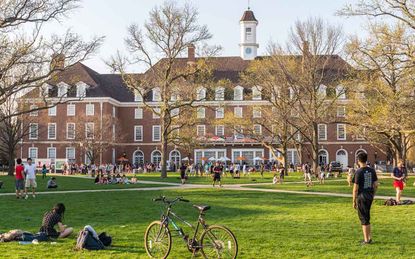
Champaign-Urbana, Ill.
- Total population: 237,849
- Share of population, age 45 to 64: 21.6%
- Retired cost of living: 9.7% below national average
- Median income, age 45 to 64: $73,227
- State's retiree tax picture: Mixed
This part of central Illinois, home to the University of Illinois and Parkland College, offers affordability with no shortage of things to do, including college sporting events, film and music festivals and educational opportunities. The metro area is also home to a number of tech startups, fostered by the University Research Park's 43,000-square-foot business incubator called EnterpriseWorks. So young retirees can enjoy small-town charms and costs while exploring and developing big ideas and innovations.

Evansville, Ind.
- Total population: 315,263
- Share of population, age 45 to 64: 27.2%
- Retired cost of living: 6.4% below national average
- Median income, age 45 to 64: $61,349
- State's retiree tax picture: Least Tax Friendly
In the southwest corner of Indiana, near the borders of Illinois and Kentucky, the Evansville metro area is a cultural hub with five distinct arts districts, as well as the University of Southern Indiana, the University of Evansville and Ivy Tech Community College. So you can find plenty of attractions and activities to entertain you throughout your long retirement, all with below-average living costs. And as you age through retirement, you may appreciate the abundance of health care facilities, including six major hospitals nearby with approximately 2,000 beds.

Des Moines, Iowa
- Total population: 623,113
- Share of population, age 45 to 64: 24.9%
- Retired cost of living: 9.2% below national average
- Median income, age 45 to 64: $80,898
- State's retiree tax picture: Not Tax Friendly
For retirees looking to live in a big city on a small budget, Des Moines is a good choice. Affordability is just one reason the Milken Institute ranked the state capital fifth out of 100 large U.S. metro areas for successful aging. Des Moines also boasts a strong economy and plenty of health care facilities specializing in aging-related services.
Retirees won’t lack for things to do, either. There are numerous museums and arts venues, including an outdoor sculpture park, a zoo and botanical gardens. There’s even a casino and racetrack in nearby Altoona that hosts annual camel, ostrich and zebra races (sorry, no wagering allowed).

Topeka, Kan.
- Total population: 233,382
- Share of population, age 45 to 64: 27.2%
- Retired cost of living: 8.2% below national average
- Median income, age 45 to 64: $65,788
- State's retiree tax picture: Least Tax Friendly
If you're looking for affordability—as early retirees should be—there's no place like Kansas. The whole state has living costs 14% below the national average. And in capital city Topeka, retirees enjoy particularly affordable housing costs, 21.6% below the national average. Indeed, the median home value in Topeka is $100,400, compared with $139,200 in all of Kansas and $193,500 across the country.
And now is a great time to take advantage of those low costs. Downtown Topeka is enjoying something of a renaissance, with a multi-million revitalization project that began in December 2012 now bearing the fruits of their labor. Improvements to infrastructure, including widening sidewalks, and the addition of new pocket parks, pavilions and public art works helped draw new businesses and restaurants. And that's just the beginning: Construction of a new plaza began just this year and is scheduled to go public in March 2020. Evergy Plaza will offer a large performance stage, a digital screen and several fountains and will convert into an ice rink for winters.
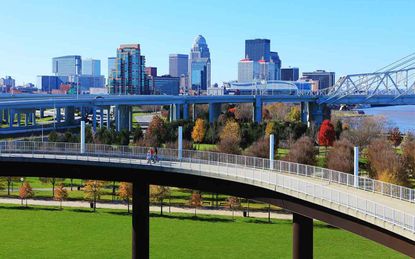
Louisville, Ky.
- Total population: 1.3 million
- Share of population, age 45 to 64: 27.4%
- Retired cost of living: 6.8% below national average
- Median income, age 45 to 64: $65,005
- State's retiree tax picture: Most Tax Friendly
The biggest city in Kentucky, Louisville is a solid blend of metropolitan attractions, southern and midwestern charm and affordability. Housing is particularly cheap at 20.3% below the national average for retirees. The median home value in Louisville is $146,900, according to the U.S. Census Bureau, a bit pricier than the rest of the state (median: $130,000) but less than the national median of $193,500. And home options are varied, from downtown apartments and historic homes in walkable neighborhoods to million-dollar houses and acres of land within and surrounding city limits.
Along with the affordability, you can also enjoy plenty of cultural attractions in Louisville, including the Kentucky Center for the Arts, which hosts traveling Broadway shows, operas, and performances by the city's professional ballet company and orchestra. Bonus: Louisville is home to the Kentucky Derby, giving fans of horses, fancy hats and mint juleps an extra reason to love it here. Also, bourbon.

Lafayette, La.
- Total population: 487,633
- Share of population, age 45 to 64: 25.4%
- Retired cost of living: 8.5% below national average
- Median income, age 45 to 64: $55,140
- State's retiree tax picture: Tax Friendly
If you're craving Cajun and Creole culture, Lafayette is the place to retire. Known as the "Cajun Capital City," the area is rich in history, distinctive foods and two-stepping tunes. Nature lovers can appreciate the area, too, located on the Mississippi Flyway and the Atchafalaya Loop of America's Wetland Birding Trail. Bird watchers have gotten a glimpse of 240 species, so far.
And all that comes with smaller costs than you'd find in the Big Easy. The cost of living for retirees in New Orleans is 1.1% above the national average.

Portland, Maine
- Total population: 525,776
- Share of population, age 45 to 64: 30.2%
- Retired cost of living: 17.1% above national average
- Median income, age 45 to 64: $77,152
- State's retiree tax picture: Mixed
The largest city in Maine, Portland offers a lively downtown and plenty of urban-esque amenities amidst the great outdoors of the Pine Tree State. You can enjoy museums, theaters and an array of eclectic dining. The flagship L.L. Bean store in nearby Freeport is a must-see for many visitors, but resident shoppers also flock to Portland’s unique boutiques and outlets.
All the while, you’re never too far from the area's many beaches. That means ample opportunity to lounge on the shore or dive into water-based activities including fishing, kayaking, sailing and even surfing. And of course, hiking and biking trails abound—perfect in the (much) colder months, too, for cross-country skiing and snowshoeing.

Lexington Park, Md.
- Total population: 110,979
- Share of population, age 45 to 64: 27.5%
- Cost of living: 12.0% above the national average**
- Median income, age 45 to 64: $105,417
- State's retiree tax picture: Least Tax Friendly
About an hour and a half from Washington, D.C., the California-Lexington Park metro area of Maryland offers a quick escape from politics to the Chesapeake Bay. And despite the local population's high incomes (and the area's abundance of millionaires), living costs are lower than much of the rest of the state—Maryland's cost of living is 24.6% above the national average. And it's far more affordable than the District, where living costs are 73.9% above the national average.
In town, you can visit the Patuxent River Naval Air Museum to peruse the collection of naval artifacts, expanding beyond just operational aircrafts and focusing on the research and testing stages of development. (While it was once an official U.S. Navy museum, due to federal budget restructuring, it is now a private non-profit organization.) And in the rest of St. Mary's County, early retirees can explore and enjoy more than 500 miles of shoreline on the Patuxent and Potomac Rivers and the Chesapeake Bay.
**Overall cost of living for all residents, according to Sperling's BestPlaces.

Pittsfield, Mass.
- Total population: 127,751
- Share of population, age 45 to 64: 30.3%
- Retired cost of living: 7.4% above national average
- Median income, age 45 to 64: $65,943
- State's retiree tax picture: Not Tax Friendly
New England is notoriously expensive, but Pittsfield offers a small pocket of relative affordability—at least more reasonably priced than the Boston metro area, where living costs for retirees are 55.6% above the U.S. average. Housing is particularly affordable: The median home value in the city, located in the western part of the state, is $173,100, compared with $193,500 for the U.S. and a whopping $455,100 for Boston proper.
Leaf peeping in the fall may be enough to draw you to the Berkshires. But you can find plenty to enjoy year round, including camping, fishing, hiking and skiing. Nearby, enjoy musical performances at the Tanglewood Music Center, the summer home of the Boston Symphony Orchestra. Art lovers may want to make short drive to the Clark Art Institute in Williamstown and the Massachusetts Museum of Contemporary Art (MASS MoCa, for short) in North Adams.
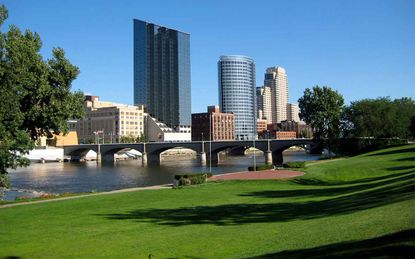
Grand Rapids, Mich.
- Total population: 1.0 million
- Share of population, age 45 to 64: 25.5%
- Retired cost of living: 2.2% below national average
- Median income, age 45 to 64: $71,042
- State's retiree tax picture: Not Tax Friendly
Michigan was hit hard by the Great Recession, when the automotive industry took a particularly sharp dive. A decade later, the business of cars has somewhat recovered, and the state's overall economic picture is generally improving. But poverty remains a big problem, especially in certain areas, including Detroit, Flint and Kalamazoo, where the overall poverty rate ranges from 31% to 42%, compared with 12.3% for the U.S., according to the U.S. Census Bureau.
Grand Rapids is in a relatively better economic state. The overall poverty rate is lower at 22.5% and is actually below average among 45- to 64-year-olds at 8.2%, versus 10.6% across the country. And while living costs are a bit higher than than they are in other parts of the state (Kalamazoo's retirees have living costs 21.1% below the national average), they're still lower than the rest of the country, and higher median incomes help cover the spread. Plus, the local art, food and music scenes, along with an abundance of outdoor recreation options, will keep you entertained. Lake Michigan beaches are just 30 minutes away. And nicknamed Beer City, Grand Rapids has an "Ale Trail" with more than 80 breweries.

Minneapolis
- Total population: 3.5 million
- Share of population, age 45 to 64: 26.7%
- Retired cost of living: 5.8% above national average
- Median income, age 45 to 64: $89,630
- State's retiree tax picture: Least Tax Friendly
If the cold winters and equally harsh tax situation don't put you off of the North Star State, the Minneapolis metro area—including state capital, St. Paul—can be a great place to retire. In fact, the Milken Institute rates it as the 14th-best large metro area for successful aging, citing its livability including low crime rate and low senior poverty rate; high engagement of its older population; long life expectancy; and many outdoor recreation options (it’s the Land of 10,000 Lakes, after all).
Young retirees might prefer the bigger of the Twin Cities. Minneapolis (city population: 425,403) offers more of an urban lifestyle—while maintaining its midwestern charm—with an active night life and vibrant music scene (it was home to the late legend Prince). St. Paul (city population: 307,695), across the Mississippi River, may be the better choice for those looking for smaller crowds, more quiet and added affordability. The median home value in St. Paul is $187,400, compared with $222,600 in Minneapolis and $199,700 in all of Minnesota. Whichever twin you choose, you'll get access to all the arts, sports and college town amenities that make the area a great place to live and retire.

Gulfport-Biloxi, Miss.
- Total population: 388,082
- Share of population, age 45 to 64: 26.3%
- Retired cost of living: 13.0% below national average
- Median income, age 45 to 64: $53,386
- State's retiree tax picture: Most Tax Friendly
First, the bad news: Mississippi is the most impoverished of all 50 states in the nation with a poverty rate of 19.8% among all residents, compared with 12.3% for the U.S. The 45- to 64-year-old cohort of the Gulfport-Biloxi metro area suffers less with a 14.1% poverty rate, but that's still greater than the 10.6% rate for the age group across the country. Plus, the state faces "extremely significant damage" due to tariffs, according to the U.S. Chamber of Commerce, making its current economic outlook unclear.
The good news: If you can head down to the Magnolia State with a healthy nest egg, the low living costs and generous tax breaks should allow you to comfortably make it last throughout your long retirement. In fact, the Gulfport-Biloxi metro area is among the cheapest in the U.S. Gulfport offers more affordable housing with a median home value of $118,300 versus $154,800 in Biloxi (and $193,500 for the U.S.). And either city affords you access to white sand beaches on the Gulf of Mexico, casinos, oodles of outdoor recreation—including kayaking, birding, fishing and shrimping, camping and golfing.

St. Louis
- Total population: 2.8 million
- Share of population, age 45 to 64: 27.5%
- Retired cost of living: 9.9% below national average
- Median income, age 45 to 64: $72,205
- State's retiree tax picture:
The Gateway to the West can be a nice place to enter retirement, especially when you retire early and need to stretch your savings extra long. Housing is particularly affordable with costs for retirees 28.6% below the national average. Indeed, the city's median home value is $123,800, compared with $145,400 for the state and $193,500 for the nation, according to the U.S. Census Bureau.
But low costs don't limit opportunities for living it up. Foodies can enjoy an eclectic collection of dining options, many influenced by the various ethnic groups that call the city home. (Italian-influenced toasted ravioli is a local favorite.) What to wash it all down with? Beer, naturally. Home to Anheuser-Busch, as well as a growing crop of craft breweries and brew pubs, St. Louis takes suds seriously. You can balance out all that good food and spirits by exploring the area's hundreds of parks and miles of trails and waterways. And as you age, you might appreciate that St. Louis also has an abundance of health care facilities, more than 40 establishments per 1,000 seniors in the metro area, double the U.S. average.

Bozeman, Mont.
- Total population: 100,733
- Share of population, age 45 to 64: 23.0%
- Retired cost of living: 2.6% above national average
- Median income, age 45 to 64: $75,219
- State's retiree tax picture: Not Tax Friendly
If you've ever dreamed of retiring to the mountains, here's your chance. Bozeman is in southern Montana, nestled in the Gallatin Valley and surrounded by majestic ranges and national forests. Yellowstone and Grand Teton national parks sit due south of Bozeman. The geography means you have to be comfortable hiking, mountain biking, skiing and backcountry exploring your way through retirement. Hunting and fishing are also popular local activities.
But don't expect total isolation. Montana State University's Bozeman campus is home to about 15,000 students. Exuberant co-eds might not be the neighbors you pictured in your mountain-view retirement destination, but you may enjoy the dining, culture and entertainment options that come with a college town.
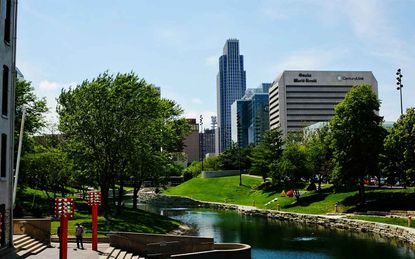
Omaha, Neb.
- Total population: 914,190
- Share of population, age 45 to 64: 24.9%
- Retired cost of living: 3.8% below national average
- Median income, age 45 to 64: $76,471
- State's retiree tax picture: Least Tax Friendly
Home to investing guru Warren Buffett, Omaha has been and continues to invest in itself, making it an increasingly attractive—and still affordable—place to live at any age. Just this year, the city has broken ground on a $300 million Riverfront Revitalization project that aims revamp an old industrial area to add housing, office space and entertainment areas. And already, you can enjoy an array of restaurants, shops, art galleries, concert halls and sporting events in town. (Some areas and activities may be disrupted by the revitalization project during the construction period, scheduled to complete in 2024.) Walking and biking trails throughout the city, along with five area lakes and two rivers, also provide plenty of outdoor activity.
All that comes at a low cost, with housing being particularly affordable. Indeed, Buffett bought his own modest home there in 1958 for just $31,500—his most famously frugal money move and what he's called the third best investment of his life (after his two wedding rings). Home prices aren't quite that cheap anymore, but the median home value of $146,500 is still relatively affordable, compared with the national median of $193,500.

Gardnerville Ranchos, Nev.
- Total population: 47,632
- Share of population, age 45 to 64: 31.1%
- Cost of living: 34.1% above the national average**
- State's retiree tax picture: Most Tax Friendly
If you retire a millionaire, you'll be in good company in Gardnerville Ranchos. The small Nevada town near Lake Tahoe is home to a surprising number of millionaires. With its prime location, the draw is understandable—across all income levels. The nearby Sierra Nevada mountain range and Lake Tahoe provide ample opportunities for hiking, biking and boating in warm weather, and world-class skiing in winter. And just about an hour away, you can enjoy big-city amenities in Reno with its downtown full of restaurants, nightclubs, art galleries, music venues and, of course, casinos.
Downside: You'll pretty much have to be a millionaire to afford the local living costs. Housing is the biggest budget killer with the median home value in Gardnerville Ranchos being $254,000, according to the U.S. Census Bureau, compared with $216,400 in Nevada and $193,500 in the U.S. Upside: State taxes are light not just for retirees, but for residents of all ages. In fact, the Silver State is one of Kiplinger's Most Tax-Friendly States in the U.S., with its low property tax and zero income tax.
**Overall cost of living for all residents, according to Sperling's BestPlaces.

Manchester, N.H.
- Total population: 406,371
- Share of population, age 45 to 64: 30%
- Retired cost of living: 10.4% above national average
- Median income, age 45 to 64: $93,052
- State's retiree tax picture: Most Tax Friendly
The Manchester metro area, including Nashua, may come with relatively high living costs, but the above-average household incomes help make them manageable. The Granite State's rock-solid tax advantages help, too. It’s a big reason why we recently ranked New Hampshire the ninth best for retirement.
Plenty of amenities make the area appealing to retirees. You can find a nice selection of restaurants in town and plenty of outdoor recreation to enjoy, including nearby snowshoeing, hiking, skiing and just taking in the scenic mountain views. And when you need a big-city escape—the city population of Manchester is just 111,196, after all—Boston is only an hour away.

Asbury Park, N.J.
- Total population: 15,511*
- Share of population, age 45 to 64: 24.2%
- Cost of living: 25.5% above the national average**
- Median income, age 45 to 64: n/a
- State's retiree tax picture: Mixed
If you're hoping for a beach-based retirement, New Jersey may not be the first place that comes to mind. But the Jersey Shore can be a lovely place to retire to, albeit generally pricey, just like the rest of the Garden State. Central and South Jersey offer a bit more affordability in retirement than the northern, New York City-adjacent region, at least. For example, in Middlesex and Monmouth counties, the cost of living for retirees is 16.1% above the national average—not quite as bad as in Bergen and Passaic counties, where it's 23.1% above the national average.
One of the relatively more affordable oceanfront towns is Asbury Park, for bad reasons. Until recently, the 1.4-square-mile city was as famous for its crime and corruption as it was for its boardwalk and beaches. But revitalization efforts over the past several years are bringing the latter characteristics back into the spotlight and adding on ritzier housing options, restaurants and shops, mainly on the east side of town. And still, Asbury Park maintains a quirky vibe with an arts and music scene that persisted even through the town's darker days.
*City population, according to the U.S. Census Bureau.
**Overall cost of living for all residents, according to Sperling's BestPlaces.

Albuquerque, N.M.
- Total population: 905,049
- Share of population, age 45 to 64: 26.1%
- Retired cost of living: 2.4% below national average
- Median income, age 45 to 64: $59,944
- State's retiree tax picture: Least Tax Friendly
You can find a lot to enjoy in Albuquerque throughout your long retirement. Local casinos—complete with concert venues, restaurants and more, along with table games, slots and bingo—help energize the local nightlife. In the light of day, you can explore the many hiking and biking trails in and around the city, go hot air ballooning, enjoy a variety of golf courses and just enjoy the 310 sunny days Albuquerque tends to get each year through all four seasons.
All that comes with below-average costs, but also below-average incomes. And many people aren't able to strike a balance: The poverty rate in Albuquerque is 18.2%, compared with 12.3% for the U.S., but better than the 19.7% rate for New Mexico.
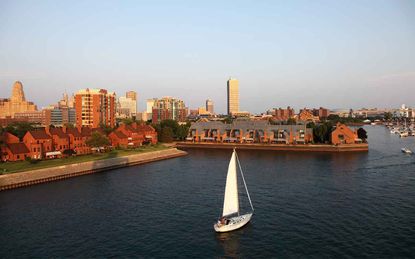
Buffalo, N.Y.
- Total population: 1.1 million
- Share of population, age 45 to 64: 28.3%
- Retired cost of living: 6.1% below national average
- Median income, age 45 to 64: $67,558
- State's retiree tax picture: Not Tax Friendly
This metro area, which includes Cheektowaga and Niagra Falls, offers a pocket of affordability in a largely expensive Empire State. Health care and housing costs for retirees are particularly low at 12.7% and 9.5% below the national average, respectively. While the median home value in New York is a whopping $293,000, compared with $193,500 for the U.S., it's just a fraction of that in Buffalo at just $77,800.
For your outdoor recreation, how do you like shoveling? The average snowfall is 94.4 inches each winter, but in four of the past six years, the accumulation has topped 100 inches, including 101.1 inches in the 2018-19 season. Once you dig yourself out, you partake in a wonderland of skiing, skating, tubing, pond hockey and a blizzard of other winter activities.

Raleigh, N.C.
- Total population: 1.3 million
- Share of population, age 45 to 64: 25.9%
- Retired cost of living: 7.3% below national average
- Median income, age 45 to 64: $82,608
- State's retiree tax picture: Not Tax Friendly
A high median income plus low living costs adds up to a good setting to stretch your savings through an extra-long retirement. Housing for retirees is particularly affordable, at 12.4% below the national average.
Part of North Carolina's Research Triangle, along with Durham and Chapel Hill, Raleigh also comes with powerhouse employers (and college sports teams) that provide the area with a solid economic base. Indeed, the state boasts one of the highest job growth rates in the U.S., and the Triangle is the center of growth in tech jobs while Raleigh also posts strong growth in professional and business services. That should give early retirees ample opportunity to dip back into the workforce as desired.

Bismarck, N.D.
- Total population: 128,673
- Share of population, age 45 to 64: 25.8%
- Retired cost of living: 2.8% below national average
- Median income, age 45 to 64: $82,884
- State's retiree tax picture: Tax Friendly
The capital city’s strong economy means plenty of employment opportunities for early retirees who want the option of popping back into the workforce, if only part time. It also means you can find an array of restaurants and shops around town, as well as attractions, including the Lewis and Clark Riverboat, the North Dakota Heritage Center, Fort Abraham Lincoln and the Dakota Zoo.
On the banks of the Missouri River, you can enjoy more active leisure in the summertime. That’s when it’s warm enough to go cruising, boating, kayaking and canoeing, as well as hiking and biking on the trails around the city and golfing at Hawktree Golf Club. Otherwise, hope you love snow. Bismarck gets an average 46 inches of snow each year, compared with an average 28 inches for the U.S. And the average temperature in January, the coldest month, is 2 degrees.

Cincinnati
- Total population: 2.2 million
- Share of population, age 45 to 64: 27%
- Retired cost of living: 4.2% below national average
- Median income, age 45 to 64: $72,675
- State's retiree tax picture: Mixed
With relatively high incomes and relatively low living costs, the numbers add up favorably for an early retirement to Cincinnati. Housing for retirees is the biggest driver of affordability, falling 17.5% below the national average. The median home value in the city is $124,200, lower than the median $193,500 in the U.S. and even the median $135,100 in all of Ohio.
Despite the cheap costs, Cincinnati is rich with big-city amenities, including an active arts and entertainment scene, plenty of restaurants and breweries, major sports teams and a healthy job market. The diverse local economy is home to eight Fortune 500 companies, as well as the University of Cincinnati and nearby Northern Kentucky University.

Oklahoma City
- Total population: 1.4 million
- Share of population, age 45 to 64: 24.1%
- Retired cost of living: 13.9% below national average
- Median income, age 45 to 64: $65,355
- State's retiree tax picture: Not Tax Friendly
The biggest city in the Sooner State charges residents little in living costs. Housing-related expenses are particularly affordable, at 27.3% below average. The median home value is $148,500, well below the nation's median of $193,500.
Cowboys may feel particularly at home in Oklahoma City (it has one of the largest livestock markets in the world). But given the area's downtown revitalization effort, everyone can find something to enjoy. The Bricktown Entertainment District has a variety of restaurants and nightlife options. And in neighboring Norman, the University of Oklahoma plays host to bigtime sporting and cultural events.

Portland, Ore.
- Total population: 2.4 million
- Share of population, age 45 to 64: 26.2%
- Retired cost of living: 28.7% above national average
- Median income, age 45 to 64: $79,111
- State's retiree tax picture: Not Tax Friendly
As the TV show "Portlandia" says, Portland is where young people go to retire, and we concur, but seriously. Young retirees can certainly appreciate the city's laid-back vibe blended with its entrepreneurial spirit. And anyone could enjoy the big-city amenities in pedestrian-friendly neighborhoods, such as the popular Pearl District, coupled with its natural diversions, including Forest Park and Mount Tabor in the city and Mount Hood and the ocean also nearby.
Less enjoyable: the high costs and tax situation.

Pittsburgh
- Total population: 2.3 million
- Share of population, age 45 to 64: 28.9%
- Retired cost of living: 1.0% above national average
- Median income, age 45 to 64: $70,254
- State's retiree tax picture: Most Tax Friendly
The Steel City is a good deal for your retirement. While overall living costs for retirees are slightly above average, housing and healthcare costs—major financial concerns, particularly as you age—are decidedly below average by 1.7% and 6.4%, respectively. Indeed, the median home value is just $108,500, compared with $170,500 for the state and $193,500 for the nation. Plus, the Keystone State offers some nice tax breaks for retirees—Social Security benefits and most other retirement income are not subject to state taxes.
Despite being light on costs, Pittsburgh is still heavy on attractions. You can enjoy the Andy Warhol Museum, the Pittsburgh Ballet Theatre, a plethora of jazz joints and all the offerings of local universities, which include Duquesne, Carnegie Mellon and the University of Pittsburgh. And if watching all the collegiate and professional sports isn't enough activity for you, you have plenty of opportunities nearby to golf, hunt, fish, bike, hike and boat.

Providence, R.I.
- Total population: 1.6 million
- Share of population, age 45 to 64: 28.1%
- Retired cost of living: 22.5% above national average
- Median income, age 45 to 64: $77,721
- State's retiree tax picture: Not Tax Friendly
Home to Ivy League Brown University and the world-renowned Rhode Island School of Design, as well as a handful of other colleges, Providence can be a great fit for intellectuals and artists looking to retire early. They'll have no shortage of things to do, with the schools offering gallery nights, performing arts events, educational opportunities and more. And their presence has helped draw a variety of restaurants and businesses to the area, too.
Unfortunately, living costs and an unfriendly tax environment can be prohibitive throughout the tiny state, and Providence is no exception.

Greenville, S.C.
- Total population: 872,463
- Share of population, age 45 to 64: 26.3%
- Retired cost of living: 2.6% below national average
- Median income, age 45 to 64: $59,527
- State's retiree tax picture: Tax Friendly
The metro area, including Anderson and Mauldin, multiplies the local population to hundreds of thousands, but the city of Greenville remains relatively small with just about 68,500. That's despite a virtual flood of new residents arriving at a rate of 15.9% since 2010, compared with population growth of just 9.9% for the entire Palmetto State and 6.0% for the U.S.
What's the big draw? Low costs and and low taxes are highly motivational for anyone looking to stretch their savings. The metro area's housing for retirees is particularly affordable at 19.8% below the national average. But note that Anderson holds all the affordability on that front: The median home value in Greenville proper is $255,600 while in Anderson, it's significantly lower at $123,200. You'll find more action in Greenville, though, with a revitalized downtown area filling with a variety of new restaurants, shops and businesses.
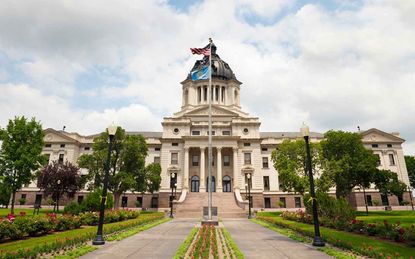
Pierre, S.D.
- Total population: 21,956
- Share of population, age 45 to 64: 27.8%
- Retired cost of living: 2.5% below national average
- Median income, age 45 to 64: $71,807
- State's retiree tax picture: Most Tax Friendly
South Dakota consistently tops our rankings of best states for retirement, what with its low living costs, tax friendliness and strong fiscal health. And while its farm economy is currently hurting from the recent tariffs situation, the financial services and tourism industries continue to hum along and contribute to the state's jobs growth.
Capital city Pierre, situated on the Missouri River, is a nice place to settle in the Mount Rushmore state, particularly for fisherman and hunters. Lake Oahe, Lake Sharpe and smaller surrounding lakes offer anglers year round action. And nearby Fort Pierre National Grassland consists of 116,000 acres of federal land, where hunters can bag pheasants, prairie chickens and sharp-tail grouse, as well as waterfowl, white-tail deer and wild turkeys.

Knoxville, Tenn.
- Total population: 862,490
- Share of population, age 45 to 64: 27.2%
- Retired cost of living: 17.4% below national average
- Median income, age 45 to 64: $58,303
- State's retiree tax picture: Tax Friendly
The Volunteer State is another good choice for budget-conscious retirees, with below-average living costs throughout the state and a friendly tax situation for all residents. It ranks fifth on our list of best states for retirement, but the tax advantages kick in well before normal retirement age with no broad-based income tax.
Knoxville is particularly affordable for retirees, compared with, say, Nashville, where living costs among retired people are a mere 1.6% below the national average. Housing costs for retirees in Knoxville are the biggest factor bringing down costs, at nearly 30% below the national average. The city's median home value is just $124,500 versus $191,400 in Nashville and $193,500 across the country. Indeed, Knoxville is one of the cheapest U.S. cities to live in.

Sherman, Texas
- Total population: 126,146
- Share of population, age 45 to 64: 26.8%
- Retired cost of living: 14.3% below national average
- Median income, age 45 to 64: $64,446
- State's retiree tax picture: Tax Friendly
This small Texas city offers big savings for retirees with below-average costs in every spending category. It's actually among the cheapest U.S. cities to live in. Housing costs are particularly cheap—27.3% below the national average for retirees. The median home value in Sherman is $106,100, compared with $151,500 in all of Texas and $193,500 in the U.S.
In town, you'll find charming amenities, such as boutique shopping, a number of unique restaurants (and many more chains) and community gatherings throughout the year, including a free summer concert series. Nature lovers might also appreciate the local 12,000-acre Hagerman National Wildlife Refuge, with more than 500 species identified so far.

Ogden, Utah
- Total population: 642,274
- Share of population, age 45 to 64: 20.7%
- Retired cost of living: 0.7% below national average
- Median income, age 45 to 64: $84,527
- State's retiree tax picture: Least Tax Friendly
Low costs plus fat paychecks can add up to big savings in Ogden. Ski aficionados, in particular, will appreciate the local world-class ski resorts, including Snowbasin and Powder Mountain, without the high price tags of, say, Provo. And even when the snow melts away, the area still covered with opportunities for outdoor adventure, as well as downtown attractions including a plethora of restaurants, shops and nightlife venues.
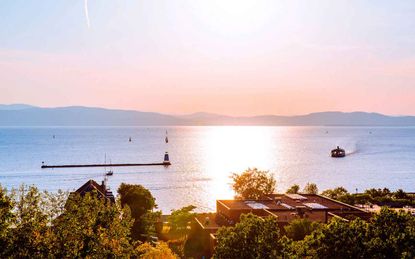
Burlington, Vt.
- Total population: 216,751
- Share of population, age 45 to 64: 27.6%
- Retired cost of living: 17.2% above national average
- Median income, age 45 to 64: $83,500
- State's retiree tax picture: Least Tax Friendly
This small mountain city on the shores of Lake Champlain is a picturesque setting for tree-hugging retirees of all ages. Outdoor recreation is plentiful with miles of hiking and biking paths, nearby beaches where you can swim, kayak or paddleboard in the warmer months, and numerous skiing options in the area. An eco-friendly vibe permeates the town, from the businesses bolstering the city's economy, such as household-products maker Seventh Generation, to the local food movement feeding the neighborhood.
Unfortunately, being green isn't easy on your wallet. Taxes and living costs are high, with housing among retirees being notably expensive at 43.2% above the national average. Indeed, the median home value is $220,600 in the Green Mountain State and $267,500 in Burlington. But if you're willing to give the workforce an encore in a remote job, the state is offering to alleviate some of that financial burden by paying you $5,000 to live there, which you could use to cover costs for moving, setting up a home office or using a co-working space.

Roanoke, Va.
- Total population: 313,069
- Share of population, age 45 to 64: 28.4%
- Retired cost of living: 10.3% below national average
- Median income, age 45 to 64: $62,803
- State's retiree tax picture: Tax Friendly
Nestled between the Blue Ridge and Allegheny mountains, Roanoke is a haven for those looking to hike through their retirements. You can find more than 600 miles of hiking trails in the Roanoke Valley—including the Appalachian Trail—ranging from easy strolls to challenging climbs. If you'd rather take in the views with less effort, try a scenic drive along the Blue Ridge Parkway. For an even more leisurely afternoon, grab a pint at one of the many local craft breweries.
Whatever you do there, you're likely to enjoy low costs while doing it. Housing is particularly affordable for retirees at 21.6% below the national average. While the median home value in Virginia is $255,800, compared with $193,500 for the U.S., in Roanoke, it's just $133,700.

Seattle
- Total population: 3.7 million
- Share of population, age 45 to 64: 26.4%
- Retired cost of living: 50.1% above national average
- Median income, age 45 to 64: $92,533
- State's retiree tax picture: Tax Friendly
Seattle has been a desirable destination for people in all stages of life for years. And its popularity is reflected in its living costs, among the most expensive in the U.S.
Still, the strong local economy and its booming tech scene, which promises typically high-paying jobs, draws high-skilled workers willing to cope with high costs. (Plus, it's still cheaper than Silicon Valley.) And the more easygoing atmosphere, encouraged by an abundance of nature and outdoor recreation opportunities in the area's many parks, trails, waterways and Cascade and Olympic mountain ranges, are big attractions for those out of the workforce, too.

Morgantown, W.V.
- Total population: 137,475
- Share of population, age 45 to 64: 23.2%
- Retired cost of living: 6.3% below national average
- Median income, age 45 to 64: $63,746
- State's retiree tax picture: Not Tax Friendly
West Virginia University offers a number of benefits to retirees in Morgantown, from sports games to cultural activities such as Broadway shows and art exhibitions to highly rated medical facilities. If you're 50 or older, you can join the local chapter of the Osher Lifelong Learning Institute. Membership, which costs $100 a year to be a full member, gets you access to interest groups, trips, social gatherings and program classes, including local and international history, music, computers and yoga. And once you're 65 and older, you can take WVU courses at a discount.
Beyond the University, you can find a world of outdoor recreation with ample opportunities for hiking, biking, fishing, birding, whitewater rafting and more.

Green Bay, Wis.
- Total population: 315,847
- Share of population, age 45 to 64: 27.6%
- Retired cost of living: 10.2% below national average
- Median income, age 45 to 64: $70,934
- State's retiree tax picture: Least Tax Friendly
The University of Wisconsin brings all the benefits of retiring in a college town to the industrial city of Green Bay. That includes a thriving cultural and arts scene, quality medical care, a walkable downtown with an array of dining and shopping options and of course sports.
And while the state's tax situation leaves something to be desired, low living costs are attractive. Green Bay is particularly affordable, with below-average costs for retirees across all spending categories. Housing expenses are notably low, with costs for retirees falling 20% below the national average. Couple that with the above-average income, and your budget should have no problem extending throughout your retirement here.

Cheyenne, Wyo.
- Total population: 97,031
- Share of population, age 45 to 64: 25.9%
- Retired cost of living: 7.9% below national average
- Median income, age 45 to 64: $75,418
- State's retiree tax picture: Most Tax Friendly
Retiring early to escape the noise and crowds of the workforce? The Cowboy State offers an abundance of space and quiet—and a scarcity of people. It has a population of fewer than 580,000—that's about six people per square mile. (By comparison, the country's smallest state in size, Rhode Island, hosts more than a million people, with more than 1,000 people per square mile.) Even the capital is relatively small, with about 64,000 residents living in the city proper.
The lack of crowds doesn't leave you a lack of activities. You have plenty of outdoor diversions, such as miles of trails for hiking, biking and horseback riding; fishing and boating; and birding and other wildlife viewing. Train aficionados can enjoy the area's railroad history and displays of locomotives, including the world's largest steam engine (also retired). Another big local attraction: Every summer since 1897, Cheyenne hosts the world's largest outdoor rodeo and Western celebration, Frontier Days, now a 10-day event.

How We Picked the Best Places for Early Retirement
To pinpoint one great retirement destination in each state, we weighed a number of factors:
- Cost of living for retirees in specified major metropolitan and micropolitan statistical areas is provided by the Council for Community and Economic Research (C2ER) through its cost of living index for retired households. The index includes costs of housing, food and groceries, transportation, utilities, health care and miscellaneous expenses. For select cities, where data specifically for retired households was not available, cost of living comes from Sperling's Best Places and includes all residents, as noted.
- Population data, including the percentage of the population that is age 45 to 64, is provided by the U.S. Census Bureau. The figures, unless otherwise noted, represent the populations of major metropolitan and micropolitan statistical areas that often include multiple cities despite being named after just the principal city.
- Household incomes, poverty rates and unemployment rates for 45- to 64-year-olds are also from the U.S. Census Bureau.
- Taxes on retirees, based on Kiplinger's Retiree Tax Map, divides states into five categories: Most Tax Friendly, Tax Friendly, Mixed, Not Tax Friendly and Least Tax Friendly.
- Average health care costs in retirement are from HealthView Services and include Medicare, supplemental insurance, dental insurance and out-of-pocket costs for a 55-year-old couple who are both retired and are expected to live to 87 (husband) and 89 (wife).
- Rankings of each state's economic health are provided by the Mercatus Center at George Mason University and are based on various factors including state governments' revenue sources, debts, budgets and abilities to fund pensions, health-care benefits and other services.
- Rankings of the health of each state's population are from the United Health Foundation and are based on more than 30 factors ranging from residents' bad habits (smoking and excessive drinking) to the quality of hospital and nursing home care available in the state.
Get Kiplinger Today newsletter — free
Profit and prosper with the best of Kiplinger's advice on investing, taxes, retirement, personal finance and much more. Delivered daily. Enter your email in the box and click Sign Me Up.

Rapacon joined Kiplinger in October 2007 as a reporter with Kiplinger's Personal Finance magazine and became an online editor for Kiplinger.com in June 2010. She previously served as editor of the "Starting Out" column, focusing on personal finance advice for people in their twenties and thirties.
Before joining Kiplinger, Rapacon worked as a senior research associate at b2b publishing house Judy Diamond Associates. She holds a B.A. degree in English from the George Washington University.
-
 Remembering Bogle: A New Standard for Municipal Investing
Remembering Bogle: A New Standard for Municipal InvestingImprovements in technology, data, systematic trading and risk analytics have led to more successful municipal indexing.
By Paul Malloy Published
-
 ‘Are You Better Off Than You Were 71 Days Ago?’ Cory Booker Marathon Senate Speech Highlights Tax Debate
‘Are You Better Off Than You Were 71 Days Ago?’ Cory Booker Marathon Senate Speech Highlights Tax DebateTax Policy A speech protesting Trump’s policies, including tax plans, breaks U.S. Senate records.
By Kelley R. Taylor Published
-
 What Does Medicare Not Cover? Eight Things You Should Know
What Does Medicare Not Cover? Eight Things You Should KnowHealthy Living on a Budget Medicare Part A and Part B leave gaps in your healthcare coverage. But Medicare Advantage has problems, too.
By Donna LeValley Published
-
 12 Great Places to Retire in the Midwest
12 Great Places to Retire in the MidwestPlaces to live Here are our retirement picks in the 12 midwestern states.
By Stacy Rapacon Published
-
 10 Cheapest Small Towns to Live In
10 Cheapest Small Towns to Live InThe cheapest small towns might not be for everyone, but their charms can make them the best places to live for plenty of folks.
By Dan Burrows Published
-
 15 Reasons You'll Regret an RV in Retirement
15 Reasons You'll Regret an RV in RetirementMaking Your Money Last Here's why you might regret an RV in retirement. RV-savvy retirees talk about the downsides of spending retirement in a motorhome, travel trailer, fifth wheel or other recreational vehicle.
By Bob Niedt Published
-
 The Cheapest Places To Retire in the US
The Cheapest Places To Retire in the USWhen you're trying to balance a fixed income with an enjoyable retirement, cost of living is a crucial factor to consider.
By Stacy Rapacon Published
-
 The Six Best Places to Retire in New England
The Six Best Places to Retire in New Englandplaces to live Thinking about a move to New England for retirement? Here are the best places to land for quality of life, affordability and other criteria.
By Stacy Rapacon Last updated
-
 13 Smart Estate Planning Moves
13 Smart Estate Planning Movesretirement Follow this estate planning checklist for you (and your heirs) to hold on to more of your hard-earned money.
By Janet Kidd Stewart Last updated
-
 Should You Rent in Retirement?
Should You Rent in Retirement?Making Your Money Last Renting isn't right for all retirees, but it does offer flexibility and it frees up cash.
By Sandra Block Last updated
